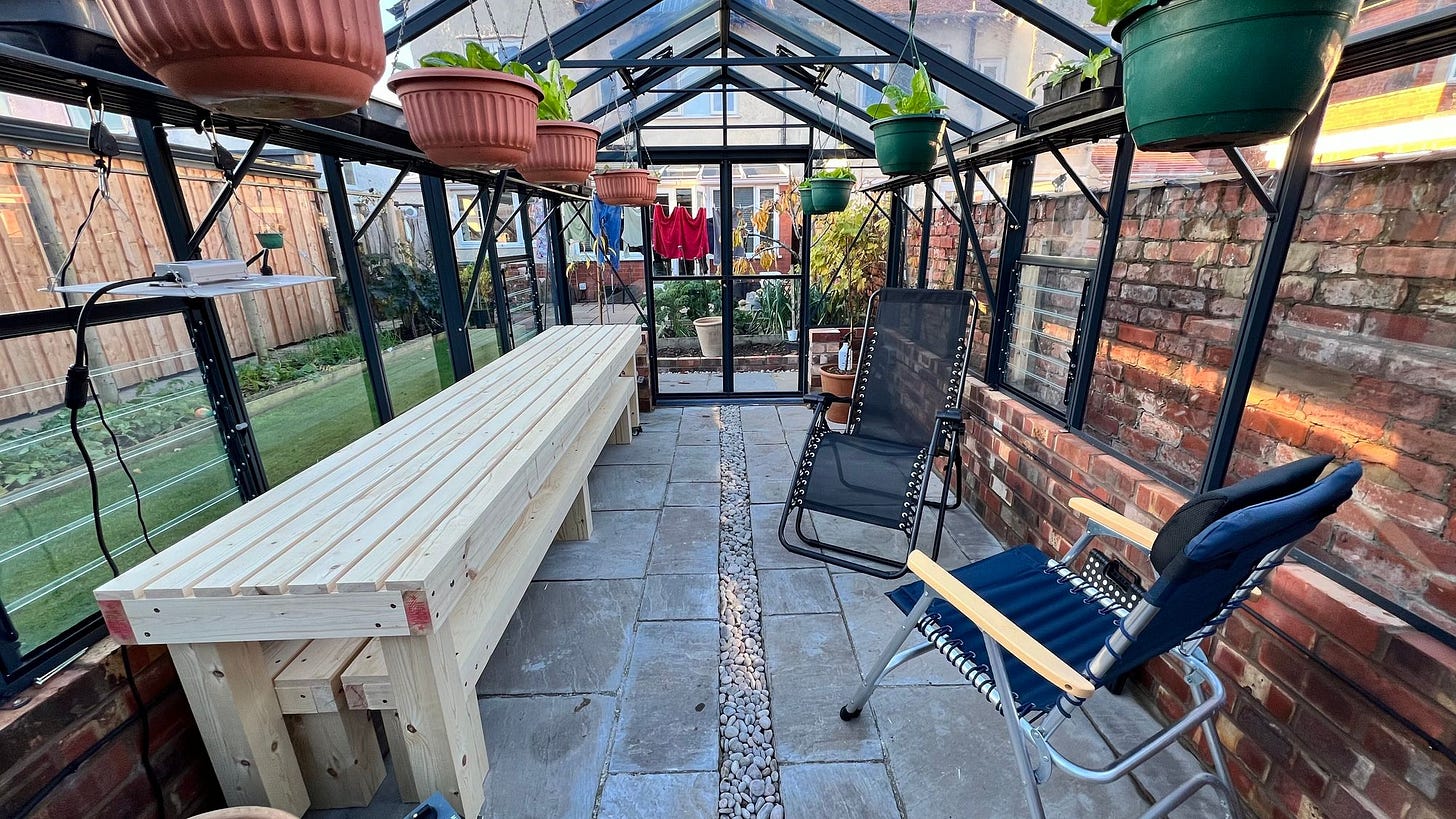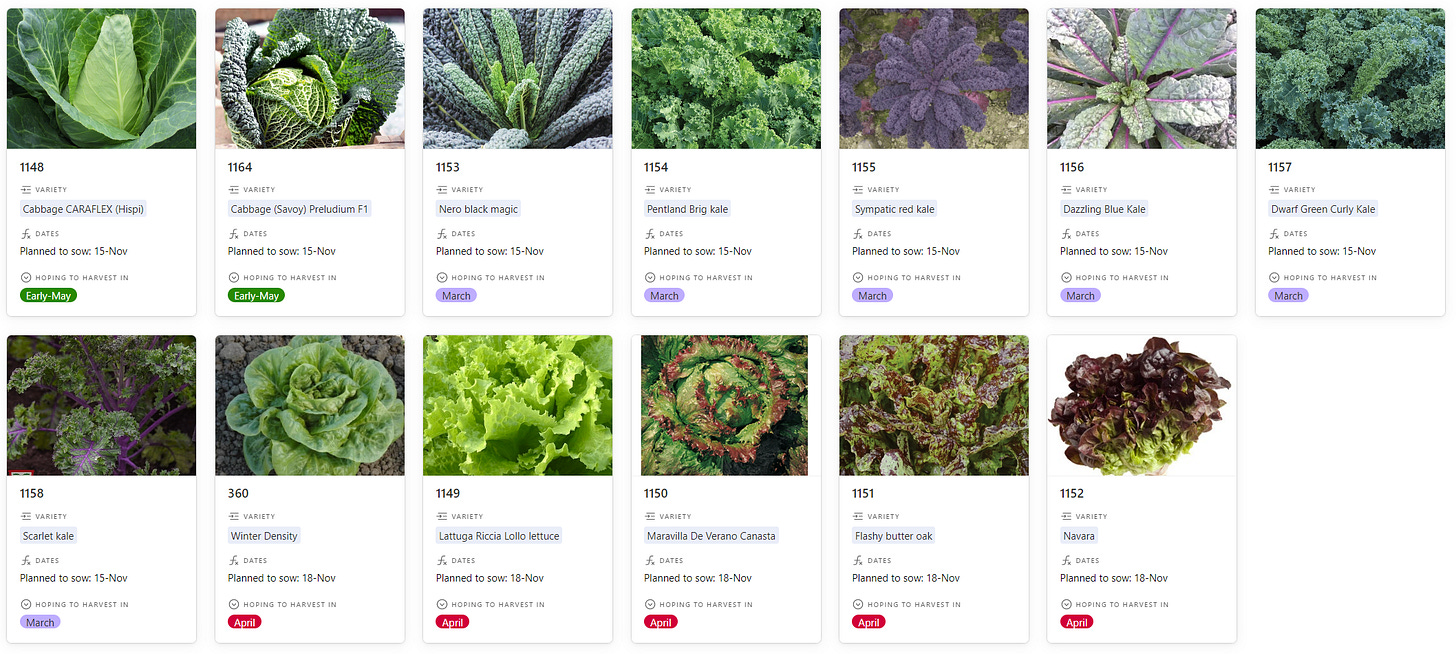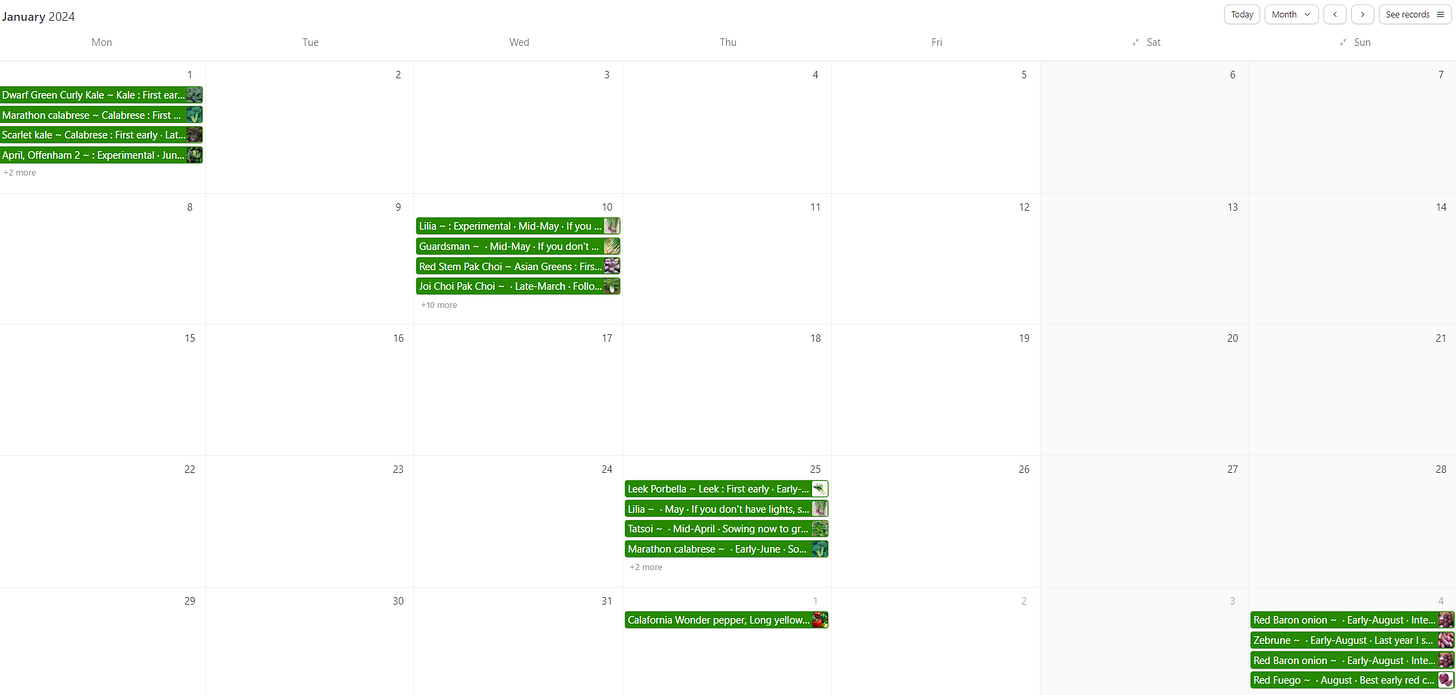Enjoying sowing
I know it seems strange for a gardener to admit that they don’t really like sowing seeds, but usually, I don’t. I dislike it because I’m not organised by nature and sowing seeds requires me to be organised. I have a sowing diary to follow, which nudges me to do a specific task on a specific day, I need to find the seed packets, write the labels and then follow a fairly careful process and repeat it many times. Making videos provides that extra nudge to make me do what I recommend others do.
My brain really rebels against this type of work. Having spent nearly 20 years of my life not knowing whether I will be able to walk or use my arms, or speak on any particular day, I really dislike having to do things at specific times or dates, having a schedule imposed on me rankles. The organisation required to find a specific seed packet, amongst thousands is anathema to me, I’m a follow my instinct, type of person. Writing labels, oh how I detest doing even a simple task like that.
For most of my career, my real strength was making decisions with insufficient information, basically being a ‘good guesser’, not exactly a job suited to a person who likes organisation, but perfect for me.
I do it all though and if I’m going to do something I will do it fairly well. Trying to be true to my 80/20 approach to almost everything, focusing on the 20% of an activity that delivers 80% of the results, skipping the 80% that delivers the remaining 20%. That means choosing a top quality seed starting compost, and quality module trays and germinating in the house, but not sieving, adding vermiculite or any other amendment, no propagators or bottom heat, nothing fancy.
I got good at living an 80/20 life because I was ill 80% of the time, so on my 20% of good days I had to get 80% of my work done, 80% is enough in most jobs, especially mine
My most frequent comment topic on YouTube concerns how ‘organised’ I am, as if that’s some super power that I possess, not knowing the effort that it requires to force myself to be organised for that seed sowing session every week. Being seen as organised makes me feel such a fraud, when I’m pretty much the exact opposite.
I really only appear organised because YouTube sees only that tiny slice of my life. The rest of the time the façade of organisation is achieved through keeping my life simple. It’s easy to be tidy if you don’t have much stuff, it’s easy to get a lot done if you live a simple life, without too many distractions. It’s easy to to have all of your gardening data at your finger tips, if you spend a few foul weather days in winter creating the systems that make it easy to track, visualise and share that data.
It’s also a lot easier to live a disorganised life if you have slack in your life, i.e. a little more money than you need, a little bit more time than you need, a little bit more energy than you need, a little bit more sleep than you need … you get the idea.
Anyway if you want to understand a little bit more about how I’ve learned to be relatively successful and disorganised, then I wrote an essay on the topic and a video to go with it, Organised Only where it Matters.
Growing good seedlings in winter
After my little rant about how I usually dislike sowing seeds, I actually love growing seedlings, because I’m a progress junkie and I love to watch the process of growth. In winter too, I have less to do, so it’s easier to enjoy sowing. It helps that I’ve created a really lovely space to do my sowing in too!
Anyway back to the topic, sowing and growing in winter, which is a lot easier than many people seem to think. There’s really only one rule that I try and follow:
Recreate the environment that the seedlings expect at their optimal sowing time, which is normally mid spring.
That means getting just four things right:
Soil temperature
Air temperature
Light levels
hydration levels
If you use a good quality seed starting compost, you don’t need to consider nutrients
Advanced growers try to force the natural world, but I prefer to mimic it instead, forcing is great if you like to live in a 20/80 world, i.e. you like doing the extra 80% of effort that gives you the last 20% of results, that’s how you win prizes and the admiration of your peers. But if you are 80/20 like me, then you do the most important 20% of an activity and are happy with 80% of the results, you don’t win any prizes, but you feed your family without much effort.
What doe’s mimicking nature mean in practice then? Well lets start with what it doesn’t mean:
It doesn’t mean germinating seeds in a heated propagator at 25c, when in nature soil never gets that warm, and everything germinates just fine at normal house temperatures of 18-20c
It doesn’t mean blasting your plants with grow lights for 18 hours a day, seedlings will really be expecting 12-14 hours at most
My simple, nature mimicking approach is as follows:
Just use the heat of the house for all germination, near a radiator for cucumbers, peppers and tomatoes, anywhere heated for the rest. In summer I seek out the coolest spots in the house instead of the warmest
Germinate somewhere with a fairly stable temperature, which usually means out of direct sunlight. Soil temperatures are remarkably stable from day to night, varying by only a few degrees, 1-2 cm down
Keep grow light day length and heat levels for seedlings around that experienced in April for cool weather crops and in June for warm weather crops
I don’t use bottom heat because a house is more than warm enough, bottom heat usually results in seedlings experiencing too much heat and too little light, so seedlings are leggy, i.e. they grow too fast and stretch upwards seeking light. I usually find it’s better to have too much light than soil heat, because that’s what seedlings expect, cool spring soil and 12 - 14 hours of sunshine
I usually water small seedlings from the top, because seedlings expect to be rained on and if I can I will make sure they have some air movement, because they expect some wind. This improves nutrient uptake and makes for stronger plants
If I see my seedlings developing a lot of leaf and lying close to the ground, they are getting too much light, so I will reduce the light intensity, or increase the heat a little
For cool weather plants, I start them somewhere that’s heavily trafficked, so I see them germinate as soon as possible and then move them under grow lights for 14 days and then into the polytunnel/greenhouse for about 3-5 days and then plant out at 21-30 days old
Planting under plastic seedlings don’t need any further hardening off
If I keep plants in pots for more than 30 days I might switch to bottom watering, or alternating top and bottom watering, because by then plants have a well developed root system and their demand for water is sufficient to cope with wetter soil, small seedlings and wet soil leads to damping off/stem rot
If you want to start your seedlings in your greenhouse, rather than inside the house though, you will definitely benefit from a propagator. Debbie and I love having seedlings in the house though, so that’s not an objective for us.
For much more on all of these topics see The Basic Gardening Skills, section of my ebook, but remember that there are many ways to be successful in gardening, this is just the approach that works for me.
Greenhouse progress
Debbie and I built the big trestle table and benches this week.
The idea is for a multi purpose table, that can be used as greenhouse staging, a very large dining table, a play bench and a work bench.
The seats, slide away nicely under the table and then are going to be used as shelves for my pots and trays, these will be stored on large gravel trays, which will work as draws for easy access and relocation.
I’ve setup a temporary grow light in there too, which will initially be used for cool weather plants, which grow best in a cool, but frost free space with high light levels. In April I will heat the greenhouse, to keep it at roughly above 11c for the warm weather crops, and to provide more light and ventilation than is possible in the conservatory and to avoid them overheating. The greenhouse benefits from a huge amount of ventilation too!
We went for just two easy fold chairs, so that we can stow them when we want more space for other activities, or for early fruits and veggies in containers.
Finally, the power is now connected. I went for double sockets in each corner, because the greenhouse is also the power source for all of the garden lighting and has so many uses beyond gardening.
Here’s the numbers:
Greenhouse size 8’ 6” by 14’ 6”
Trestle table size 10’ by 2’
High shelving for seedlings in module trays 28’
Storage shelving 20’ by 2’ deep
4 corner spaces for patio trees and early veg (cucumber and beans)
Sowings for the week
Although I’m still not fully recovered I have at least got around to sowing some seeds and I’m all caught up now. Here’s the full list for this week:
Here’s everything sown to date, in more detail
Not germinated yet
So much germinated this week!
Most of these seedlings are now on the top of the wardrobe in the unheated bedroom with the windows open during the day, this is where I have my best grow lights.
There are a few hold outs, no sign yet of the garlic and annoyingly another batch of Grenoble Red failed me.
Seedling progress
Right now I have nothing else ready to plant and nowhere to plant it anyway, but space will start to open up by the end of November and I should be ready with lettuce and spinach for spring.
Here’s a list of everything that I have that’s not yet planted, I don’t know why carrots are on this list, I need to fix that.
Again, here’s the link to my actual database which should be easier to read!
Pricked out
Nothing this week, but quite a lot next week!
Potted on this week
Nothing this week, but quite a lot next week!
Planted this week
Nothing this week and probably next week, unless I need to replace anything that the slugs get to
Sowing’s for next week
Quite a bit and I’m excited to be starting a whole new set of experiments. With growing early brassicas for spring, without tying up beds space in autumn and winter for them. All these will need grow lights.
This link take you to all of my monthly guides, where you can find a lot more than just my growing guides. I particularly like the list of videos produced in the relevant month in years gone by. Here’s a list of them (click the image if you want).
Relaxing December and January
I take a rest from gardening in December and January, as to a large extent the gardens just yield harvests for very little effort. There’s very little to sow in December and almost nothing if you don’t have grow lights. That said if you do have grow lights, you can keep life interesting and reduce the effects of seasonal affective disorder at the same time.
That doesn’t mean I stop thinking about gardening though, we continue to harvest, I do most of my planning and writing in mid-Winter and the allotment is still a lovely place to spend time. I’ve already started tinkering with a new feature in my database, a sowing calendar view for the whole year. It’s nowhere near finished and the data is a little shoddy, but you can click on the image below if you want to try it:
If all goes to plan you should - with a couple of clicks - be able to include an always up to date view of my sowing calendar directly in your own personal calendar, with lots of extra features that I’m hoping to make possible.
Downloadable resources
Last month I experimented with providing downloadable versions of my database for September and October. I’ve updated these below with the latest information.
For even more details and a more up to date list check out my live plan here.
Bulk harvests
Bulk harvests are over now!


















The trestle table looks great! Very versatile. I like the idea of the google calendar entries - I think that will be very helpful. At the moment I constantly refer to your sowing log so that would cut out a few steps. I have just finished sowing my lettuces and spinach with previous ones now all planted out in polytunnel and beds. About to use my new growlight for first time having got it all set up now! I have two 40 cell trays ready to use the lights over once seeds have germinated. Any suggestions how high above the trays I should set the lights at? (Not enclosed, trays are on an open table)
I just had an idea of what could be very helpful to me in the individual growing guide. Would you consider entering examples of the dates you actually sowed, planted and harvested (and for how long) on a calendar timeline (like on the back of seed packets) rather that just the range they could be as of course that could be all different ranges of time over the year?
I wonder what stage the plants are at when you start and stop harvesting? I know it has come up in videos but a flash back and timeline for a specific bed would be really interesting. It may well take up too much of your time and what you already do is great, but just thought I'd pass on my ideas, Thanks Sreve, Justine
Hello. I bought my supplies from
https://www.gourmetmushrooms.co.uk/shop/
They have a good range including winter growing mushrooms and are super helpful